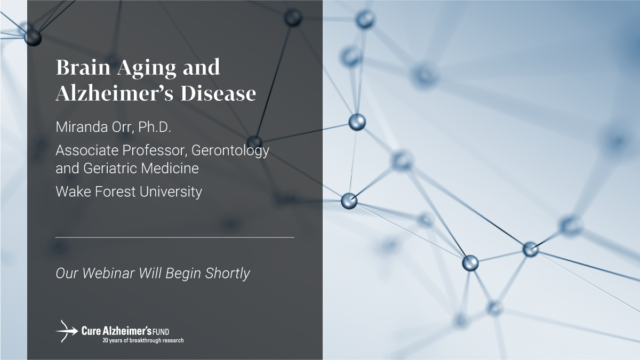
Webinar: Brain Aging and Alzheimer’s Disease
In this 28 minute webinar, Dr. Miranda Orr of Wake Forest University discusses her research into understanding the aging brain and its relationship to Alzheimer’s disease.

—

Miranda Orr, Ph.D., Wake Forest University
Does a Genetic Mutation Prevent Alzheimer’s Disease?
In a study exploring the interaction between genetics and Alzheimer’s disease (AD) pathology, researchers discovered how the APOE3 Christchurch (APOE3ch) mutation protects against AD. Through support from Cure Alzheimer’s Fund, an APOE3ch mouse model was created, allowing researchers to investigate the influence of the Christchurch mutation on amyloid and tau pathology. The findings showcase how APOE3ch revs up the efficiency of microglia surrounding amyloid plaques to remove aggregated tau. Although APOE3ch reduced the levels of amyloid beta, its real power was the ability to prevent the spread of tau, which precedes neuronal death and dementia. These findings reinforce the potential of APOE3ch as a genetic shield against AD, and present a novel perspective on the genetic mechanisms leading to AD resilience.
—

Marco Colonna, M.D., Jason D. Ulrich, Ph.D., & David Holtzman, M.D.,
Washington University in St. Louis
Why Are Some People Resilient to Alzheimer’s Disease Pathology?
Despite high levels of amyloid beta plaques and tau tangles in their brain, some individuals never develop symptoms of dementia in their lifetime. Resilience to pathology leading to Alzheimer’s disease (AD) may be associated with reduced levels of neuroinflammation, thought to be universal in symptomatic AD. But what in the AD brain could be triggering excessive neuroinflammation has remained elusive. A breakthrough study uncovers the origin of resilience to the pathology leading to AD.
—

Teresa Gomez-Isla, M.D., Massachusetts General Hospital
Karen E. Duff, Ph.D., University College London
Exercise and Alzheimer’s Disease: The Protective Power of Irisin
Engaging in physical exercise may bolster overall health and act as a safeguard for our brain, particularly with respect to Alzheimer’s disease (AD). Using a 3D cell culture model designed to mimic AD pathology, scientists discovered that the hormone irisin, which is released from the muscles during exercise, increases the production of neprilysin in specific brain cells known as astrocytes. Upon its release from astrocytes, neprilysin breaks down amyloid beta, the protein that forms harmful plaques in AD. Consequently, the levels of amyloid beta were significantly reduced. These results cast exercise and irisin in a new light as potential deterrents against the development of Alzheimer’s disease, and highlight a new therapeutic angle to prevent amyloid beta accumulation.
—


Joseph Park, Ph.D., Luisa Quinti, Ph.D., Doo Yeon Kim, Ph.D.,
Christiane Wrann, D.V.M, Ph.D., Rudolph Tanzi, Ph.D., & Se Hoon Choi, Ph.D.,
Massachusetts General Hospital
Insights From the Aging Mouse Brain
Aging is the biggest risk factor for developing sporadic Alzheimer’s disease. But the changes that take place in the human brain as we age, leading to increased risk, remain largely unknown. A new investigation set out to identify the molecular underpinnings that occur in the aging brain. As a result, it was discovered that previously unsuspected regions of the brain are more vulnerable to aging, and two anti-aging treatments can rejuvenate the brain in unexpected ways.
—

Tony Wyss-Coray, Ph.D., Stanford University
Thank You for Your Generosity
Thank you for your generosity as we continue to fund research into Alzheimer’s disease. One way to contribute is through Qualified Charitable Distributions (QCDs), paid directly from an Individual Retirement Account to a charity, and may provide tax advantages.
—The Cure Alzheimer’s Fund Team

